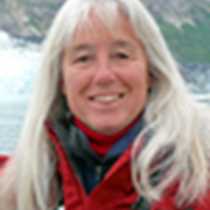Half Moon Bay, Isla San Francisco
The National Geographic Sea Lion was anchored in an idyllic location this morning. The rising sun highlighted the multi-hued volcanic cliffs of the Sierra de la Giganta (Mountains of the Giantess) on the Baja California Peninsula, which we enjoyed from our vantage point in Half Moon Bay at Isla San Francisco. Those on deck witnessed an amazing scene and a competitive drama that continued throughout the day. Looking over the ship’s railings, we noticed dense shoals of small fish, which attracted brown pelicans looking for a meal. Whenever the pelicans dove, Heermann’s gulls flew in to try to rob a few fish. Kleptoparasitic frigatebirds were also out to steal a few morsels. Local fishermen deployed their hand-thrown atarraya nets to entrap bait for their livelihood. There was enough for everyone, except if you were one of the unlucky sardinas. This manifestation of the food web is indicative of the profusion of richness and productivity in the Sea of Cortez.
We had time to pursue many activities at this site. The water was chilly but very inviting for snorkelers who wanted to glimpse the colorful world below the surface. Kayakers investigated the rocky shoreline and could even see urchins and coral in the clear, shallow water. A hike to the narrow ridgeline afforded magnificent views and even some distant whale blows. On the other side of the island, low tide yielded more treasures: a zebra worm, a synapted sea cucumber, apricot sea slugs, a Mexican dancer (another type of sea slug), hermit crabs, brittle stars, and a sun star among them.
Myriad celestial stars scintillated through this evening’s dark sky, as tiny bioluminescent organisms glittered in the ebony depths, reminding us of the vastness and complexity of the universe.
The National Geographic Sea Lion was anchored in an idyllic location this morning. The rising sun highlighted the multi-hued volcanic cliffs of the Sierra de la Giganta (Mountains of the Giantess) on the Baja California Peninsula, which we enjoyed from our vantage point in Half Moon Bay at Isla San Francisco. Those on deck witnessed an amazing scene and a competitive drama that continued throughout the day. Looking over the ship’s railings, we noticed dense shoals of small fish, which attracted brown pelicans looking for a meal. Whenever the pelicans dove, Heermann’s gulls flew in to try to rob a few fish. Kleptoparasitic frigatebirds were also out to steal a few morsels. Local fishermen deployed their hand-thrown atarraya nets to entrap bait for their livelihood. There was enough for everyone, except if you were one of the unlucky sardinas. This manifestation of the food web is indicative of the profusion of richness and productivity in the Sea of Cortez.
We had time to pursue many activities at this site. The water was chilly but very inviting for snorkelers who wanted to glimpse the colorful world below the surface. Kayakers investigated the rocky shoreline and could even see urchins and coral in the clear, shallow water. A hike to the narrow ridgeline afforded magnificent views and even some distant whale blows. On the other side of the island, low tide yielded more treasures: a zebra worm, a synapted sea cucumber, apricot sea slugs, a Mexican dancer (another type of sea slug), hermit crabs, brittle stars, and a sun star among them.
Myriad celestial stars scintillated through this evening’s dark sky, as tiny bioluminescent organisms glittered in the ebony depths, reminding us of the vastness and complexity of the universe.




